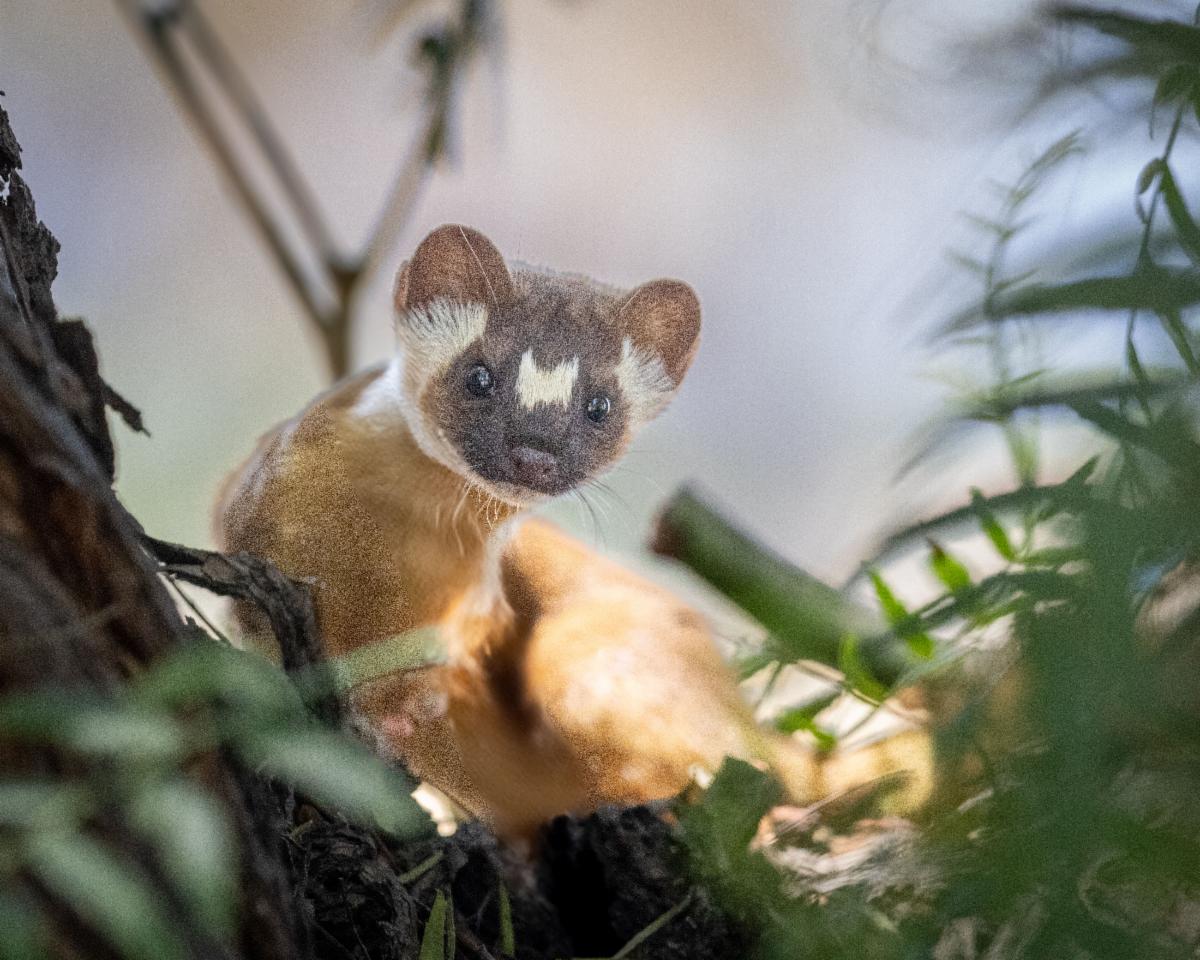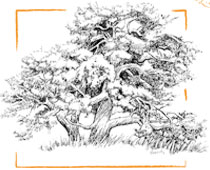By Nikki Evans

Throughout the winter and spring, word of long-tailed weasel sightings popped up all around Sedgwick: docents spotting one in a pipe near the Sedgwick pond, visitors getting little glimpses of weasels running around the landscaping near the Tipton meeting house, staff seeing one scurrying across a trail by the observatory. Long-tailed weasels’ range includes most of the United States, but most people will never see one. They are sensitive to habitat fragmentation and do not thrive in urbanized environments. Add to this their small size and tendency to spend a good deal of time in underground tunnels and you have a creature that is hard to find. Yet, we are lucky in the Santa Ynez Valley to have ample open space for these territorial carnivores to survive.
I had the good fortune to see several this summer, the first popping up from a hole in Sedgwick’s oak grove while I was working at a nearby picnic table. At first, I spotted only its long black-tipped tail, a hallmark feature of long-tailed weasels, as it disappeared into a hole. The black tip of a long-tailed weasel’s tail acts as form of crypsis, attracting predators away from the head and main body. It is particularly useful in the northern subspecies who turn entirely white during the winter with the exception of this tail.
In hopes of seeing her again, I lowered myself to the ground and gently scooted closer to the hole. Some minutes later, she popped up from another hole just a little further away. Tucking her chin into her chest, ears alert, she eyed me warily but remained poised, halfway out of the hole. I sat, breathless, unblinking, afraid she would leave if I moved. But weasels, in the same family as ferrets, are curious creatures. After staring at one another for some moments, she broke eye contact, popped up and down a few times, and then disappeared into the hole. Given her very small size, this was likely a female. They can be half the size of the males.

I scanned all the nearby holes, feeling like I was in a real live game of ‘whack a mole’ waiting to see where she would pop up. The next time she came up, she raised her nose into the air, sniffing gently, looking like a curious puppy. Long-tailed weasels have a keen sense of smell, useful for tracking prey. They also emit a musky smell themselves that can communicate territory and reproductive states to other weasels. Perhaps she was smelling for other weasels, perhaps she was smelling me. After a few sniffs, she disappeared again.
We engaged in a few more rounds of this game, with her emerging in and out of holes, sometimes surprisingly close. Weasels do not create their own tunnels; they generally reuse those of squirrels and other animals. Despite not being the creator, she seemed quite at ease navigating this tunnel system.

After it seemed she left for good, I walked the area and came upon a dead gopher snake, possibly this weasel’s food. Long-tailed weasels need to eat about 35% of their body weight in a day; imagine a 150-pound person consuming 55 or so steaks in a day. The contradiction of this fact is that they cannot eat too much at once. They have to maintain their slender form if they are going to fit through narrow tunnels. Due to these needs, they have a habit of stashing carcasses and returning for many small meals throughout the day.
Adept Carnivores
Weasels hunt like jaguars, leaping from behind and attacking important blood vessels in the throat. This gopher snake had died with his mouth wide open, seemingly gasping for air. While I stood out in the field marveling, a few docents were returning to the field station. As they walked by, I popped up from the field and asked if they wanted to “see something weird” whereupon I showed them the ghastly gopher snake. I must admit, working at a place like Sedgwick Reserve, there are moments where you catch yourself bringing up things that simply wouldn’t be socially acceptable in most places: an invitation to view a dead snake, a pondering about scat, a discussion about dismembered insect parts left by pallid bats. It is a unique culture.

This habit of killing more than they can eat gives long-tailed weasels a bad name among chicken owners. A long-tailed weasel can decimate an entire flock in moments. Living with wildlife puts the onus on us humans to create weasel-proof coops. They will target easy to enter coops and so the best thing to do is cover any gaps and make sure there are no holes larger than an inch in diameter. These long slender animals can fit through amazingly small spaces. While they may garner a bad reputation due to their surplus killing habits, they are also a boon to farms and natural areas due to their habit of eating primarily small rodents and protecting vegetation that would have been eaten by these rodents. In that way, they are important regulators of the environment. Long-tailed weasels and barn owls both eat around 3 rodents per day/night. Perhaps there will come a time when people maintain underground tunnels to house weasels for the ecosystem services they provide, similar to the way people build boxes to house owls.
Some weeks later, I was lucky enough to see another weasel, this one running across the street and up into a pepper tree. This weasel climbed around the trunk and from branch to branch like he spent his entire life climbing trees. These terrestrial creatures are surprisingly good at climbing. Though I have not personally seen this, I have also read that they are adept swimmers. These tiny creatures are perfectly suited to pursue prey across many terrains.


Conserving long-tailed weasels
While long-tailed weasels are considered a species of ‘least concern,’ a 2021 study published in peer-reviewed journal PLOS ONE suggests their numbers have declined rapidly since 2000. They are not a particularly well-studied species. As small, active animals, weasels are susceptible to vehicle collisions. Other threats include cats (put a bell on your outside cats or consider a catio instead), lack of sufficient hunting territory due to fragmentation, starvation due to rodent decimation, and secondary poisoning by rodenticide due to a diet consisting mainly of rodents.

In the northern parts of its range, climate change plays a unique role. The white winter coat provides camouflage in the snow. However, decreasing snowfall due to climate change also increases the number of days the weasel’s winter camouflage is mismatched with its environment. This increases the chance of predation and decreases the chance of hunting success. These color changes appear to be genetic and triggered by shortening periods of sunlight. A weasel moved from Montana to southern California would still turn white in the winter. When the climate changes so rapidly, the slow pace of evolution cannot keep up.
Long-tailed weasels are fascinating and ferocious creatures that we are lucky to see in the Santa Ynez Valley. Living with long-tailed weasels means better controlled mice populations, the need for secure chicken coops, and the possibility of magical encounters with this unique and beautiful creature.
